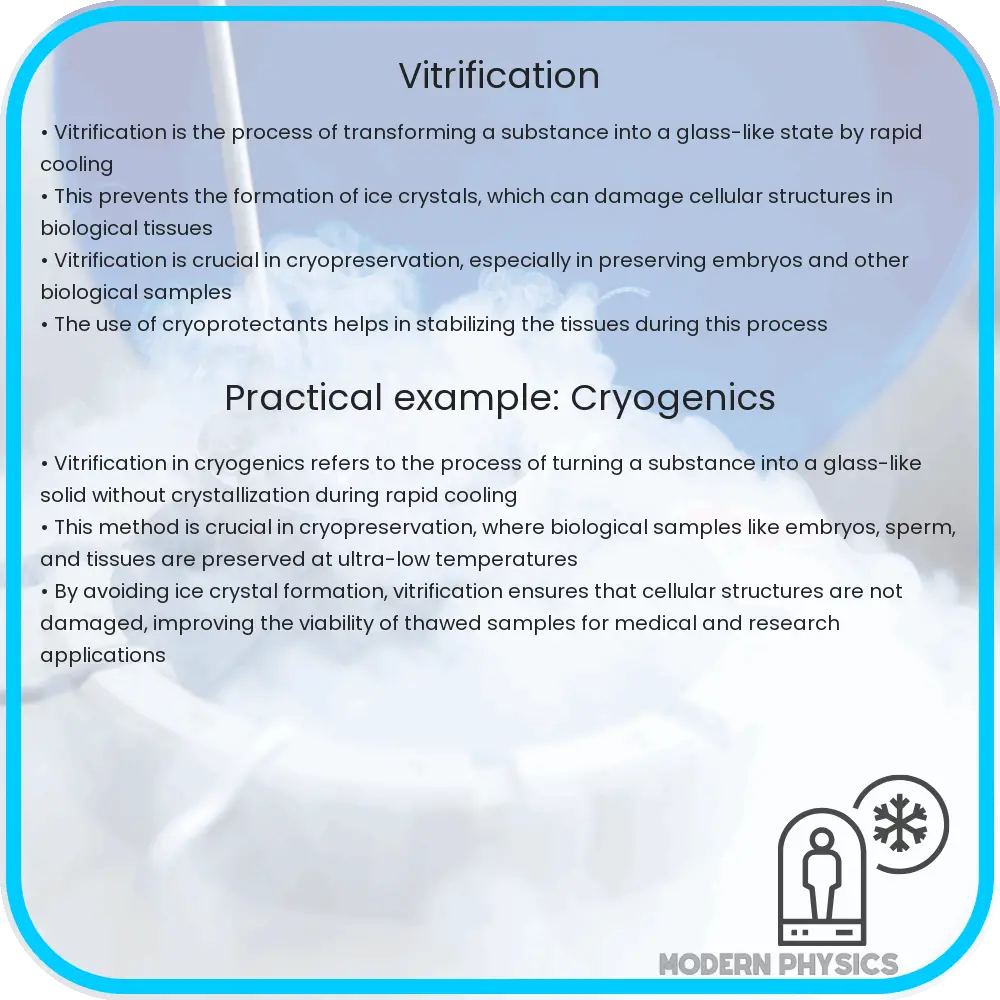Vitrification is the process where materials transition into a glass-like, amorphous state through rapid cooling, preventing crystallization.

Understanding Vitrification: The Science of Making Durable and Transparent Materials
Vitrification is a fascinating process in physics and materials science that involves the transformation of a substance into a glass-like state. This process is critical in creating materials that are not only durable and resilient but also maintain a high degree of transparency. In this article, we’ll delve into the basics of vitrification, exploring how it occurs, its applications, and why it is vital in the production of some of today’s most indispensable materials.
What is Vitrification?
At its core, vitrification is a transition of materials from a liquid to a glassy state. This change happens not by regular crystallization, but through a rapid cooling process that prevents the formation of a regular crystal lattice. The term “vitrification” comes from the Latin “vitrum,” meaning glass. The process effectively bypasses the typical crystalline solid state and results in a disordered, amorphous structure similar to glass.
The Physics Behind Vitrification
The key to understanding vitrification lies in the behavior of molecules as they cool down. Under normal conditions, when a liquid is cooled, the molecules reduce their movement and start arranging into a structured, crystalline solid. However, if the cooling process is sufficiently rapid, there is not enough time for these molecules to form an ordered structure. Instead, they remain in a disordered state, similar to the liquid but with the viscosity and mechanical stability of a solid.
To describe this transformation, the concept of glass transition temperature, Tg, is crucial. Tg is the temperature below which the liquid’s molecules do not have enough thermal energy to overcome their mutual attraction and rearrange into a crystal lattice. Instead, they ‘freeze’ in place, leading to the formation of a glassy solid.
Applications of Vitrified Materials
Vitrified materials find extensive applications in various fields due to their unique properties. One of the most well-known uses is in the production of glass for windows, bottles, and other containers. However, the applications extend far beyond these everyday items:
- Electronics: Vitrified materials are crucial in the electronics industry for making durable and transparent insulating layers and substrates in microchips.
- Waste Management: In nuclear waste management, vitrification is used to encase hazardous materials in glass, significantly reducing the risk of contamination and leakage.
- Art and Restoration: Artists and restorers use vitrification to create and preserve works of art, particularly in ceramics and glasswork.
Why Vitrification Matters in Material Science
The ability to control the glass transition and understand the properties of vitrified materials is a cornerstone of modern materials science. By manipulating the rate of cooling and the chemical composition of the material, scientists and engineers can design materials with tailored properties for specific applications, combining transparency, durability, and resilience in ways that conventional crystalline solids cannot match.
In summary, vitrification is more than just a scientific curiosity; it’s a vital industrial process that has applications ranging from everyday items like glassware to advanced technologies in the electronics and nuclear industries. In the following sections, we will delve deeper into the specific properties of vitrified materials and how these are tested and utilized in various technological fields.
Testing and Measuring Properties of Vitrified Materials
Understanding the properties of vitrified materials is essential for their application in technology and industry. Tests to measure mechanical strength, transparency, and chemical stability are common. One critical aspect of testing involves assessing the material’s hardness and resistance to environmental stress to ensure longevity and performance under varying conditions.
Additionally, spectroscopic methods like infrared spectroscopy and Raman spectroscopy are used to probe the molecular structure of vitrified materials. These techniques help scientists understand how the arrangement and bonding of molecules in these amorphous solids contribute to their unique properties.
Challenges and Future Directions in Vitrification
Despite its vast applications, vitrification faces challenges, particularly in scalability and cost-effectiveness. Research is ongoing to develop more efficient cooling technologies that could make the process more accessible and environmentally friendly. Furthermore, the pursuit of new materials that can withstand higher temperatures before devitrifying (turning back from glass to crystalline form) is a significant area of focus.
Future advances in nanotechnology and materials science may lead to innovative uses of vitrification, such as creating super-tough materials for aerospace applications or even more efficient solar panels. Moreover, the application of vitrification technology in biological preservation, like cryonics or the storage of biological samples, holds tremendous potential for biotechnology and medicine.
Conclusion
Vitrification stands as a remarkable process within materials science, offering a bridge between the liquid and solid states of matter with its unique non-crystalline, glass-like properties. Its significance extends beyond simple household glassware to cutting-edge applications in electronics, waste management, art restoration, and beyond. Understanding and enhancing this process remains a critical focus area in materials science and engineering, driving progress in numerous technical and industrial fields.
By continuing to explore and refine the processes and applications of vitrified materials, scientists and engineers not only contribute to technological innovation but also to the sustainable practices that will benefit future generations. Vitrification, thus, not only encapsulates a critical scientific process but also symbolizes a pathway to more durable, efficient, and groundbreaking material solutions.
